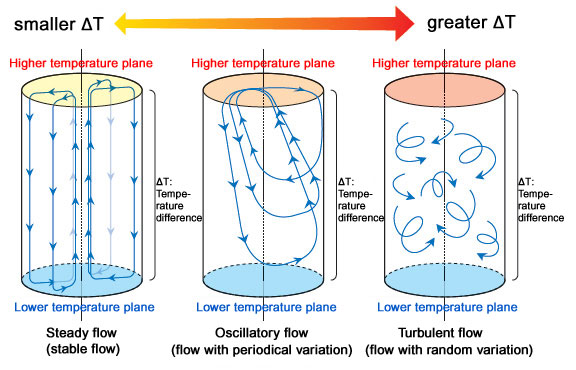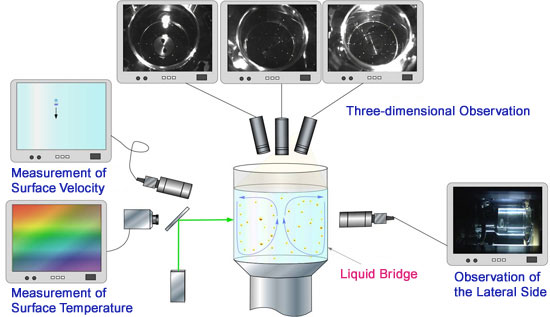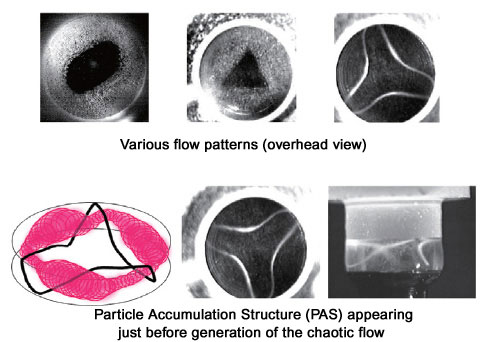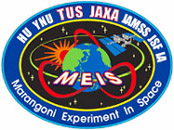This is an archive of information released in the past.
Disclaimer: It may contain broken links or outdated information. Some parts may not function in current web browsers.
*Visit https://humans-in-space.jaxa.jp/en/ for the latest information.

Experiment
- News
- Kibo Utilization Strategy
- Kibo Utilization Plan
- List of JAXA's Utilization Themes
- Experiment Facilities
- Space Environment Utilization
- Archive
Theme 1
Chaos, Turbulence and its Transition Process in Marangoni Convection (Marangoni Exp/MEIS)
- The fifth series of Marangoni Exp/MEIS experiment completed (April 11, 2013)
Theme 2
Spatio-temporal Flow Structure in Marangoni Convection (Marangoni UVP/MaranGoniat)
- Marangoni UVP/MaranGogniat-2 Begins (February 1, 2011)
- Marangoni UVP/MaranGogniat-1 Completed (July 16, 2010)
- Marangoni UVP/MaranGogniat-1 Begins (February 1, 2010)
Theme 3
Experimental Assessment of Dynamic Surface Deformation Effects in Transition to Oscillatory Thermo capillary Flow in Liquid Bridge of High Prandtl Number Fluid
Background and purpose of the experiment
Water forms into droplets on surfaces of a lotus leaf or a well-waxed car.
This is because water has “surface tension”.
Surface tension is force acting on a liquid such as water, and works to make the surface area of the liquid as small as possible.
The surface tension depends on the temperature of the liquid and concentration of dissolved matter: normally, surface tension becomes higher when temperature is lower.
This means that gradient of surface tension is generated by temperature differences in a lateral direction on the surface, and concentration differences when oil or alcohol is put on the water surface generate, and it causes a surface flow toward the area with higher surface tension.
Figure 1 shows this process.
The induced surface flow pulls the liquid under the surface and generates a flow (convection) in the liquid.
This phenomenon is called “Marangoni convection”, named after Italian physicist Marangoni who first studied this phenomenon in the 19th century (Figure 1).
Marangoni convection during production of silicon crystals for semiconductors negatively affects the quality of the crystals. The convection also occurs in a heat pipe for heat radiation devices of personal computers, and degrades the radiation performance.
Therefore, increased understanding of Marangoni convection not only expands our knowledge of behavior of a fluid, but also has great significance for production of semiconductor material and equipment development for space use.
Naturally, studies of Marangoni convection require clear observation of its effects.
However, it is difficult to observe the effects of Marangoni convection on Earth because the convection is weaker than thermal convection (buoyancy convection) caused by gravity. That is why space experiments of Marangoni convection under microgravity environment are helpful.
The following three experiments will be performed by using the Fluid Physics Experiment Facility (FPEF). Although all of them study Marangoni convection, each of them has unique features with a different method of observation and analysis.

Figure 1. Development process of Marangoni convection
Outline of the Experiment
1. Preparation of a Large Liquid Bridge
In a Marangoni convection experiment, a cylinder of liquid is prepared and imposed the temperature difference between its ends.
On the Earth, however, the cylinder (a liquid bridge) is deformed by gravity, so the experiment can be performed only with a liquid bridge of less than several millimeters in diameter.
For the same reason, the height of a liquid bridge for the experiment is limited on Earth.
Therefore, a microgravity environment is needed to study systematically various phenomenon caused by Marangoni convection.
A Marangoni convection experiment starts with preparation of liquid bridges of 1 cm, 3 cm and 5 cm in diameter, and those ranging from 1 cm to a few centimeters in height, which can not be made on Earth.
2. Generation of Convection
The temperature differential is applied between the ends of a large liquid bridge to generate Marangoni convection.
As the temperature difference between the ends is increased, the initial stable flow (steady flow) turns into a flow with periodical variation called an oscillatory flow. And then the flow falls into a state called “Chaos” before it eventually becomes completely disordered and called “a turbulent flow” (Figure 2).

Figure 2. Flow Variation
3. Observation of Convection
Three-dimensional Observation:
Small particles will be mixed into a liquid in advance for the liquid bridge, and movement of the particles will be tracked by using three cameras to observe flow patterns inside the liquid bridge (Themes 1 to 3 experiments).
UVP Observation:
Ultrasonic Velocity Profile (UVP) method using an ultrasonic wave Doppler Effect will be also used to measure the flow (Theme 2 experiment).
Measurement of Surface Temperature:
Surface temperature of the liquid bridge will be measured to study the relationship between temperature distribution and convection inside the liquid when Marangoni convection occurs (Theme 1 to 3 experiments).
Measurement of Surface Velocity:
The surface velocity of the liquid bridge is measured by marking the surface with a laser beam to understand the relationship between the surface flow and the interior flow (Theme 1 experiment).
Although there is the theory that surface deformation plays an important role in transition from a steady flow to an oscillatory flow inside the liquid bridge, it remains unproved.
In order to verify the theory, the surface of the liquid bridge will be observed close-up for accurate measurement.
The surface temperature of the liquid bridge will be also measured to examine the surface deformation and flow (Theme 3 experiment).
In pervious experiments on Earth and in space, particle accumulation, in which particles in the liquid accumulate to form a distorted-ring shape by Marangoni convection, has been discovered.
This particle accumulation will be observed in detail to understand its generation processes (Theme 1 experiment).

Figure 3. Diagram of Fluid Physics Experiment Facility

Figure 4. Particle Accumulation observed from above and the side
(Image credit: Tokyo University of Science)
 |
Theme 1: Principal Investigator Koichi Nishino Professor, Yokohama National University |
 |
 |
Theme 1: Principal Investigator Hiroshi Kawamura Professor, Tokyo University of Science, Suwa |
|
Theme 2: Principal Investigator Shinichi Yoda Professor, JAXA |
 |
Theme 3: Principal Investigator Yasuhiro Kamotani Professor, Case Western Reserve University |
| Copyright 2007 Japan Aerospace Exploration Agency | Site Policy |